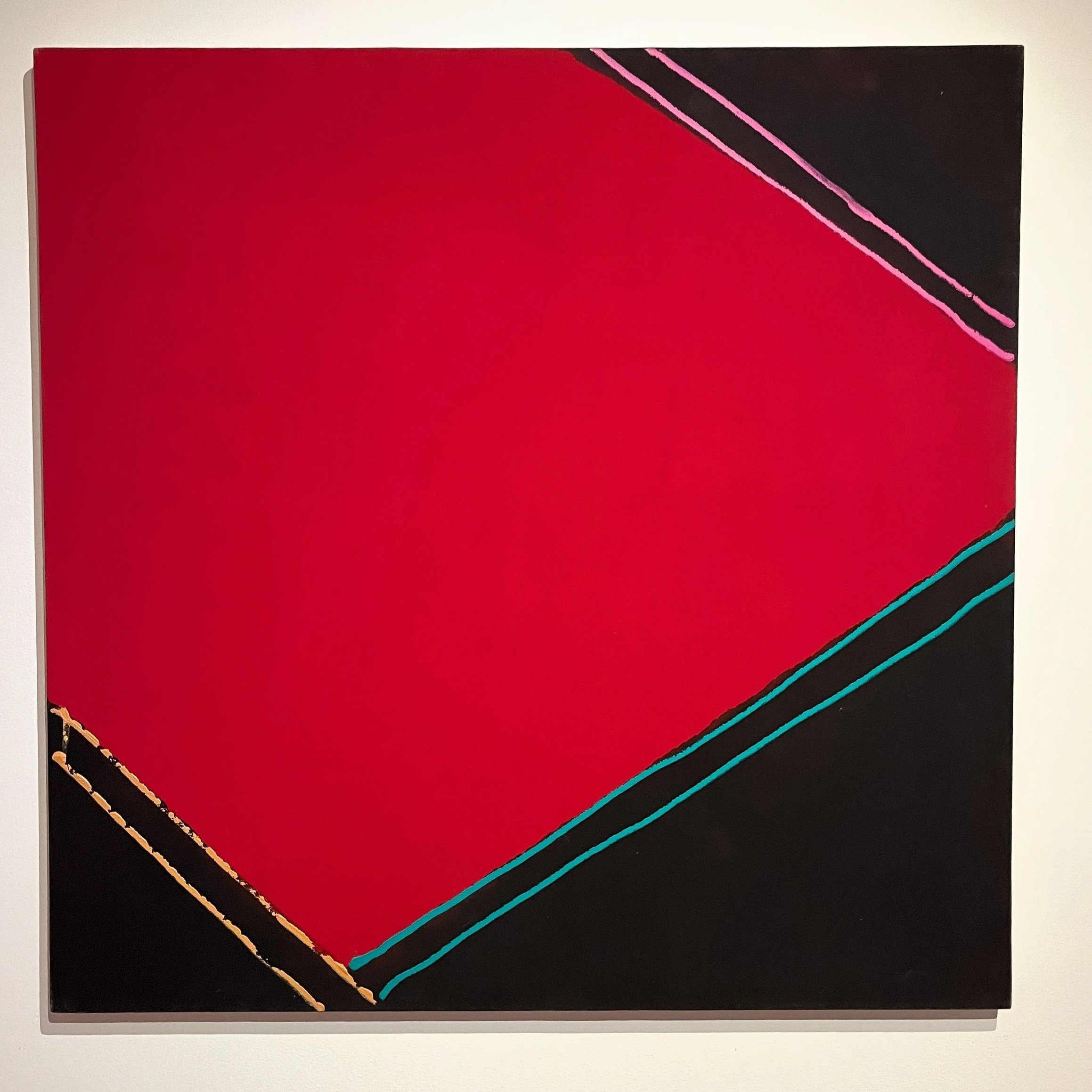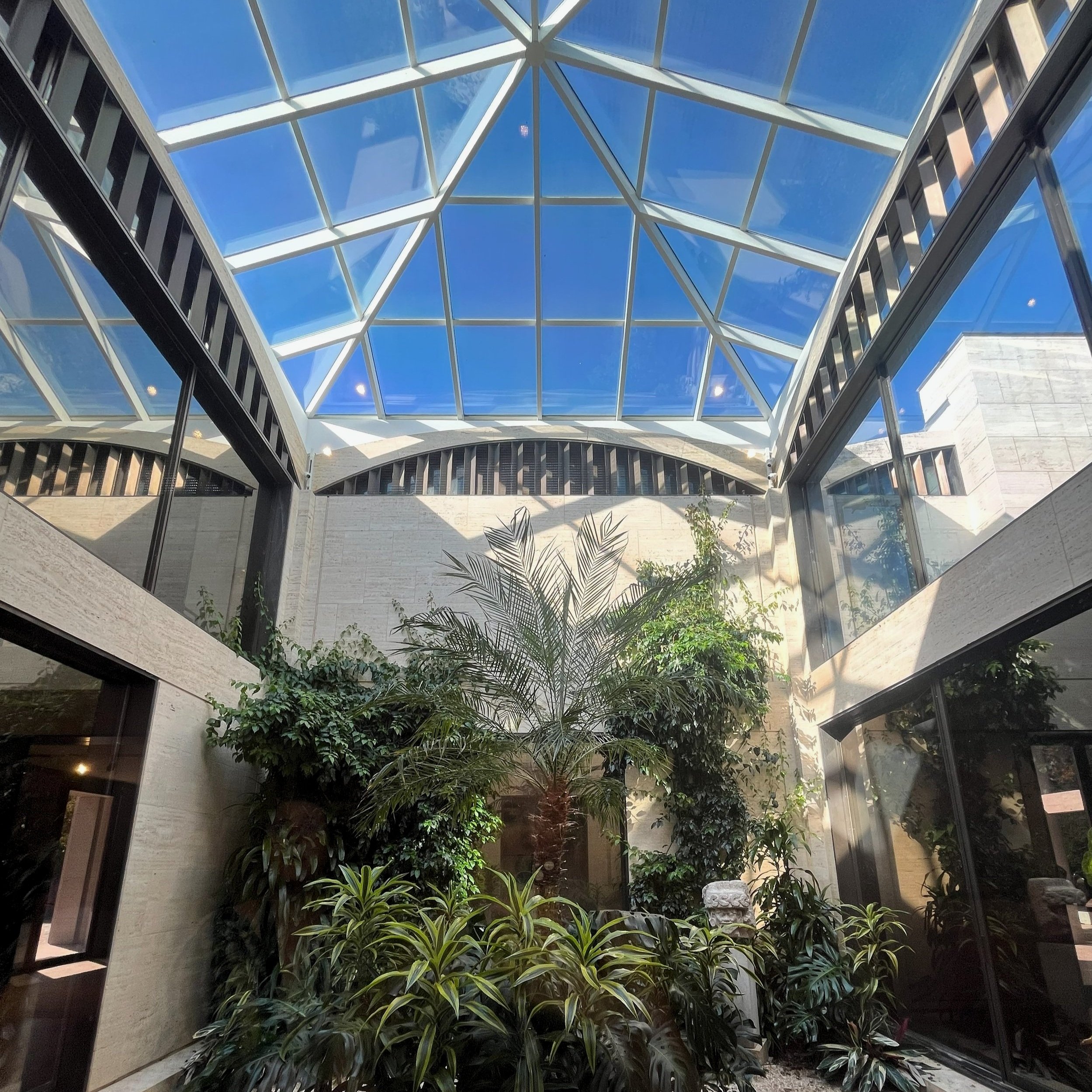The Kreeger Museum
A personal collection in a unique yet intimate setting
[Dutch version below photo gallery]
The Smithsonian museums on the National Mall dominate the cultural landscape of Washington DC. However, there is much more to explore beyond the typical tourist attractions. For instance, the Kreeger Museum on Foxhall Road offers one of the most intimate art viewing experiences in the city. The modernist travertine building, designed by Pritzker Prize-winning architect Philip Johnson, stands as a masterpiece on its own. Originally designed as a residence for Carmen and David Kreeger, the building was intended to host musical performances and display over two hundred works from the Kreeger collection. Today, the building continues to echo with the presence of architecture, art, and music.
The Kreegers acquired their collection between 1952 and 1988. Their collection of paintings, drawings, prints, and sculptures was built upon their love and admiration for both the artwork and the artists themselves.. For example, when they first saw the paintings of Mexican artist Leonardo Nierman in the late 1950s, they were immediately drawn to his works with primary colors and dynamic abstract forms. They then introduced Nierman to potential collectors and dealers, and an exhibition of his works at the Kreegers helped launch his successful career in the United States.
A professor at Rutgers University advised to "avoid fixed habits of perception and preference" when appreciating art, which encouraged David Kreeger to embrace diversity when building the collection. The Kreegers’ collection includes a wide variety of styles and subjects, from Impressionism to experimental abstract art, to traditional art from West and Central Africa and Asia.
The French Impressionists are represented with nine paintings by Claude Monet, as well as works by Auguste Renoir, Alfred Sisley, and Camille Pissarro. Eleven works from throughout Pablo Picasso's career offer a good sense of the diversity of the artist. Other 20th-century European artists include Edvard Munch, Max Beckmann, Jean Dubuffet, Wassily Kandinsky, Joan Miró, and Piet Mondrian. The still life "Dying Sunflower" from 1908 in the Kreeger collection is unlike Mondrian's characteristic geometric abstractions of non-colors and primary colors. However, Mondrian created expressive images of flowers throughout his career, often a single flower in a withered state.
American artists in the collection include Alexander Calder, Clyfford Still, Frank Stella, and James Rosenquist. Artists from Washington, DC represented in the collection include William Christenberry, Gene Davis, Thomas Downing, Sam Gilliam, and Betsy Stewart. The Kreegers were also the first collectors in Washington, DC, to give Native American art a prominent place in a permanent art collection - ooften excluded from art historical conventions at the time. The traditional artworks from West and Central Africa and Asia remain a minority in the Kreeger collection but testify to the Kreegers' boldness and openness to new aesthetic experiences.
In the 1960s, the Kreeger house was designed by renowned architect Philip Johnson, with his then-partner Richard Foster. It was one of the last residential commissions Johnson accepted. Johnson himself was a collector of contemporary art, making him the ideal architect for the project. The house was intended to function as a home to live with their art and music, as well as a museum after their lifetime. The building clearly reflects modernist influences: the openness of the main rooms, large windows for natural light, and the interactions between inside and outside, the use of geometric shapes and lines. However, Johnson also added more exotic touches to the architectural style, with playful vaults, vertical pillars, consistent use of travertine, and an exceptional glass atrium filled with tropical plants from Puerto Rico, Carmen Kreeger's birthplace. The result is an interesting fusion of modernism with elements of Byzantine architecture.
The serenity of the building is defined by the consistent use of materials, with travertine appearing both inside and outside. The neutral color palette also contributes to this atmosphere. Timeless shades flow from the exterior walls to the tapestries with meticulously arranged paintings. The structure of the building is exceptionally unified. Each room is based on a 22-foot cubic unit. Depending on the size of the room, one or more of these cubic units were used in the design. This creates seamless transitions between rooms without losing a sense of calm.
Sculptures by Jean Arp, Aristide Maillol, Henry Moore, Isamu Noguchi, and Francesco Somaini are displayed on the outdoor terrace. It is a dynamic space framed by a vaulted roof structure with massive columns. Looking through the columns, one gazes out onto the 'Reflecting Pool Terrace.' The terrace around the pool is entirely made of travertine, as is the rest of the building. Six large sculptures by local artist John L. Dreyfuss from his ‘Inventions’ series embellish the terrace. This space is also used for concerts and events. The exhibition space extends to the 5.5-acre wooded area where the Kreeger Museum is located. The grounds feature several installations, including a kinetic sculpture by George Rickey, the work "Against the Day" by Richard Deutsch, where visitors are invited to interact with the granite stone elements, and "Flame of Friendship" by Leonardo Nierman, which symbolizes the close relationship between the artist and the Kreegers.
Since 1994, the Kreeger Museum has been opened in the former home of the Kreegers. In accordance with their wishes, it continues to be an intimate, small-scale museum where visitors can experience their personal collection in an elegant setting. TThe museum’s secluded location in Washington, DC, adds to its serene and intimate atmosphere. The collection, combined with the modernist architectural gem designed by Philip Johnson, makes the Kreeger Museum a worthwhile detour from the tourist and political core of Washington DC.
2401 Foxhall Road, NW, Washington D.C. 20007, Verenigde Staten
Foto’s (c) Cultuurtoerist.
De Smithsonian musea aan National Mall domineren het culturele landschap van Washington DC. Er is echter nog meer te ontdekken dan wat bovenaan de toeristische lijsten prijkt. Zo biedt het Kreeger Museum aan Foxhall Road één van de meest intieme kunstkijkervaringen van de stad. Het modernistische gebouw uit travertijn ontworpen door Pritzker prijs winnaar Philip Johnson, is een kunstwerk op zichzelf. Het werd ontworpen als woonhuis voor Carmen en David Kreeger, als een plaats voor muzikale optredens en tentoonstellen van de meer dan tweehonderd kunstwerken in de verzameling van de Kreegers. Architectuur, kunst en muziek weergalmen vandaag dan ook doorheen het pand.
De Kreegers verwierven hun collectie tussen 1952 en 1988. Hun verzameling schilderijen, tekeningen, prenten en beeldhouwwerken werd aangelegd door hun liefde en bewondering voor het werk en de artiest. Wanneer ze bijvoorbeeld eind de jaren 1950 de schilderijen van Mexicaanse kunstenaar Leonardo Nierman zagen, waren ze instant aangetrokken door zijn werken met primaire kleuren en dynamische abstracte vormen. Ze stelden vervolgens Nierman voor aan potentiële verzamelaars en handelaars, alsook zorgde een tentoonstelling van zijn werken bij de Kreegers voor een succesvol startschot van de artiest zijn carrière in de Verenigde Staten.
Het advies van een professor aan Rutgers universiteit om “vaste gewoontes van perceptie en voorkeur” te vermijden bij het waarderen van kunst, moedigde David Kreeger aan om diversiteit te omarmen tijdens het aanleggen van de collectie. De Kreegers verzameling omvat een grote verscheidenheid aan stijlen en onderwerpen, van impressionisme tot experimenteel abstracte kunst naar traditionele kunst uit West- en Centraal-Afrika en Azië.
De Franse impressionisten zijn vertegenwoordigd met negen schilderijen van Claude Monet, evenals werken van Auguste Renoir, Alfred Sisley en Camille Pissarro. Elf werken verspreid doorheen de carrière van Pablo Picasso geven een goed beeld van de diversiteit van de kunstenaar. Andere Europese kunstenaars uit de twintigste eeuw zijn Edvard Munch, Max Beckmann, Jean Dubuffet, Wassily Kandinsky, Joan Miro en Piet Mondriaan. Het stilleven ‘Stervende zonnebloem’ uit 1908 in de Kreegers collectie is niet te vergelijken met Mondriaans typerende geometrische abstracties niet-kleuren en primaire kleuren. Mondriaan maakte echter gedurende zijn hele carrière expressieve afbeeldingen van bloemen, vaak een enkele bloem in verwelkte staat.
Amerikaanse kunstenaars in de collectie zijn onder andere Alexander Calder, Clyfford Still, Frank Stella en James Rosenquist. Tot de vertegenwoordigde kunstenaars uit Washington DC behoren William Christenberry, Gene Davis, Thomas Downing, Sam Gilliam en Betsy Stewart. De Kreegers waren daarnaast de eerste verzamelaars in Washington DC die inheemse kunst een prominente plaats gaven in een permanente kunstcollectie. Een subgenre dat destijds vaak buiten de kunsthistorische voorschriften werden gehouden. De traditionele kunstwerken uit West- en Centraal-Afrika en Azië blijven een minderheid in de verzameling van de Kreegers maar ze getuigen van hun lef en openheid voor nieuwe esthetische ervaringen.
In de jaren 1960 werd het Kreeger huis ontworpen door gerenommeerde architect Philip Johnson met toenmalige partner Richard Foster. Het was een van de laatste woonopdrachten die Johnson aanvaardde. Johnson was zelf een verzamelaar van hedendaagse kunst en bijgevolg de uitgelezen architect voor de opdracht. Het huis moest fungeren als woonhuis om samen met hun kunst en muziek te leven maar ook als museum na hun leven. Het pand heeft duidelijk modernistische invloeden: de openheid van de hoofdvertrekken, grote glaspartijen voor natuurlijk licht en interacties tussen binnen en buiten, gebruik van geometrische vormen en lijnen. Johnson gaf echter ook meer exotische accenten aan de bouwstijl. Er zijn speelse gewelven, verticale pijlers, een consistent gebruik van travertijn en een uitzonderlijk glazen atrium gevuld met tropische planten uit Puerto Rico, het geboorteland van Carmen Kreeger. Het levert een interessante kruising van modernisme met elementen van Byzantijnse architectuur op.
De sereniteit van het gebouw wordt bepaald door het consistent gebruik van materiaal, zowel binnen als buiten komt travertijn terug. Ook het neutrale kleurenpallet draagt hieraan bij. Tijdloze tinten lopen door van de buitengevel tot aan de wandtapijten met minutieus gerangschikte schilderijen. De structuur van het pand is uitzonderlijk eenduidig. Elke ruimte is gebaseerd op een kubus van tweeëntwintig voet per zijde. Afhankelijk van de grootte van de ruimte zijn er steeds één of meerdere van de kubussen eenheden gebruikt bij het ontwerp. Zo vloeien de kamers in elkaar over zonder een gevoel van rust te verliezen.
Sculpturen van Jean Arp, Aristide Maillol, Henry Moore, Isamu Noguchi en Francesco Somaini hebben een plaats gekregen op het buitenterras. Het is een energieke ruimte omkaderd door een gewelfde dakstructuur met massieve zuilen. Doorheen het kader van de zuilen kijk je uit op het ‘Reflecting Pool Terrace’. Het terras rondom het zwembad is volledig opgebouwd uit travertijn, net zoals het doorheen het volledige pand. Zes grote sculpturen van lokale kunstenaar John L. Dreyfuss uit zijn Inventions-serie sieren het terras. De ruimte wordt daarnaast gebruikt als locatie voor concerten en evenementen. De expositieruimte wordt doorgetrokken naar het 5,5 hectare bebost gebied waarop het Kreeger museum zich bevindt. Op het domein zijn meerdere installaties te zien zoals een kinetisch sculptuur van George Rickey, het werk ‘Against the Day’ van Richard Deutsch waarbij de bezoekers uitgenodigd worden om interactie aan te gaan met de granieten stenen onderdelen en ‘Flame of Friendship’ van Leonardo Nierman wat de nauwe relatie van de kunstenaar met de Kreegers symboliseert.
Vanaf 1994 werd het Kreeger Museum geopend in het voormalige woonhuis van de Kreegers. Naar wens van Carmen en David Kreeger blijft het een kleinschalig museum om hun persoonlijke verzameling te ervaren in de meest voorname omstandigheden. De afgelegen locatie in Washington DC bevordert de intieme sfeer van het museum. De collectie en de modernistische parel van de hand van Johnson maken het Kreeger museum de omweg uit het toeristische en politieke hart van Washington DC waard.










































